Recognizability is My Biggest Pursuit: Interview with Anneke van den Hombergh
- OGP

- Sep 15, 2018
- 13 min read
Updated: Oct 23, 2022
By OGP Editors / Anneke van den Hombergh Provides File Photos
Oh Good Party
We’ve been going to art collections for over 30 years, and have a bit of experience. It doesn’t compare with that of a specialist, however. we can look at an object and have a sense of whether it is worth collecting. We are empiricist, and haven’t received any teaching or instruction on what is good and what is bad. But please remember—— choose only artworks that you are passionate about. Don’t buy fakes and don’t buy damaged objects. Look at genuine pieces, and draw comparisons as often as you can. Without comparisons, collecting is no different from shopping. Strive to get to know the artists and their works as best as you can, and enjoy the process. To be a collector, you must have these fundamental skills.
Background
Anneke van den Hombergh, born in Netherland, is a professional glass artist, entrepreneur, designer and creator. Her love for art and glass art has always been a part of her. In 2007, Anneke created her brand "Anneke van den Hombergh Glass Art". Her art sculptures go all over the world and directly to customers for example UAE, UK, Germany, and France.
Interview
OGP:Five years ago we were in Seattle, saw glass as an art form of fire, breath, light, and gravity . That was a dazzling display of massive, colorful, intricate glass shows by internationally famous, Seattle-based blown-glass sculptor Dale Chihuly (1*). Over the years, he has been an innovator who carry out his distinctive vision, changed the way many collectors think about glass, stretching the medium to new realms of possibility. The truth is that as a decorative and functional medium, glass was extensively developed in Egypt and Assyria. Invented by the Phoenicians, glass was brought to the fore by the Romans. In the Middle Ages, the builders of the great Norman and Gothic cathedrals of Europe took the art of glass to new heights with the use of stained glass windows as a major architectural and decorative element. Glass from Murano, in the Venetian glass is the result of hundreds of years of refinement and invention. Murano is still held as the birthplace of modern glass art. To the 19th Century it was the summit of the old art glass movement while the factory glass blowers were being replaced by mechanical bottle blowing and continuous window glass. Great ateliers like Tiffany, Lalique (2*), Daum (3*), Gallé (4*), the Corning schools, and Steuben Glass Works increased glass art to new levels. Today, we are honored to invite the glass artist Anneke van den Hombergh. Please tell us about your artistic background, and what has inspired you to become a professional glass artist?
Anneke:I was born in a small town in the South of the Netherlands and raised in a family of hard working parents who had their own business, entrepreneurship. Perseverance has taught me very young. The interest in art has always been there and the enormous fascination especially in glass art has been a part of me, my whole life. But in the beginning it started by only in looking at art and reading lots of books about art and famous artists. The fascination in especially glass art, however, was so great that at some point I started private studies in addition to my (nine to five) job. I also learned the chemical knowledge and studies in colors in order to understand the material I worked with. My enormous urge for perfection in combination with perseverance has made me completely self-taught and has quickly set my own style and signature. The interest of customers developed at such a high speed, which ultimately led me to take the biggest step at that time and act as a professional and full-time artist. Glass fusion, sandblasting, cold techniques, casting and modernized stained glass design are the most important techniques I perform in my own studio. But from some point of view, a career in trade and sales was more obvious than a profession in the art world.
Oh Good Party
Some people become artists because they have a desire kind of energy to release, communicating their ideas to the audiences. That ’s why artists are creative.
OGP:Some people become artists because they have a desire kind of energy to release, communicating their ideas to the audiences. That ’s why artists are creative. But furthermore I also agree with you. It is very difficult for the artists to concentrate on creation because of all day entangled by the business of things. Modern works of glass art can be seen in the dedicated glass museums and museums of contemporary art. These include the Chrysler Museum in Norfolk, Virginia, the Museum of Glass in Tacoma, the Metropolitan Museum of Art, the Toledo Museum of Art, and Corning Museum of Glass, in Corning, NY, which houses the world's largest collection of glass art and history, with more than 45,000 objects in its collection. Whether an artist can succeed or not ultimately depends on his work. What makes your artistic style and glass sculptures unique and different from others? And was there anyone or anything significant that has influenced your art and designs?
Anneke:My artistic style is abstract and always engaging, timeless and mostly very colourful. From a wonderful balance in my life, I can continue to develop my fascination for techniques, colours and shapes, to refine the designs. This colour, shape and technique sophistication make the object unique and different from others and no copies can be made. In addition, the beautiful standards that are tailor made for each item and finished and polished at the highest level. My inspiration is working in my studio between lots of high quality glass. Music is one of my most important sources of inspiration in life and work. But my biggest inspiration is my beloved husband who constantly encourages me. He gives me the opportunity to discover and develop myself and take all the time needed to work and innovative creations. In addition, he is also responsible for making the standards. And my mother. She was a great example of a woman in all her simplicity and soberness but with a huge willpower. I learned a lot from her for example to follow a dream if you want to. I believe it is my great will to distinguish from myself from others and despite following setbacks, continue to follow my dream. My husband Henk gave me the opportunity to do this and to accomplish it. This makes me sometimes obsessively perfectionist.
Anneke van den Hombergh
As a full-time independent artist, very hard work is the first requirement but always working form my basics in life. When you do things from your soul you feel a joy every day.It is my “goal” in life. Always strive for improvement and renewal and never take for granted and always keep learning.
OGP:Shall I compare thee to a summer’s day? Thou art more lovely and more temperate; Rough winds do shake the darling buds of May, And summer’s lease hath all too short a date; Sometime too hot the eye of heaven shines, And often is his gold complexion dimmed, And every fair from fair sometime declines, By chance, or nature’s changing course untrimmed; But thy eternal summer shall not fade, Nor lose possession of that fair thou ow’st (from Shakespeare's Sonnets by William Shakespeare)…… When in eternal lines to time thou grow’st, So long lives this, and this gives life to thee. The difference between an ordinary marriage and an extraordinary marriage is in giving just a little ‘extra’ every day, as often as possible, for as long as we both shall live. You are so lucky! Glass art could capture the light and color. It has a lot of durability, but it’s also fragile and can break at any moment. The art-form is an ancient craft and is also at the forefront of technology, which touches our lives in many way. Through the experience of art it can also have an extraordinary impact on people. Glass artists always push the boundaries of the medium in terms of colour, form, scale, and light. In recent years maybe it has become something more—an established art form, and an attractive investment. Certainly, we believe the public and collectors also would give them the recognition and acclaim they deserve.
Anneke:Thanks! I work with my husband and maker of the standards / bases. The standards have a high finishing level. This unique collaboration makes an object always handmade and a real piece of soul and art. Every details had been hand made. My art objects most of the time find their way in the (interior) market. Mostly private customers who purchase an item directly from me. My selection and choice in partners in cooperation is highly considered. At the moment, I work with fine and good permanent partners in the high end interior market. For example, my wall object on stainless steel with glass and liquid gloss are trendsetting and have been shown in leading magazines. And My art sculptures go all over the world and directly to customers for example UAE, London, but also Germany, and France. Perfectionism ensures that the works now find themselves in the high end market. Currently I am negotiating an interior fair in the "exclusive" market in London and Dubai. Over the years my work has grown enormously in every possible way. Still, I always like to work with colors, but also when using serene colors, every combination of glass shape and color combination is always considered and never left by chance. My color, shape and technique is quirky and recognizable as a true "Anneke". Once seen, you will immediately recognize my work. It has its own distinctive signature. Recognizability is my biggest pursuit. As a full-time independent artist, very hard work is the first requirement but always working form my basics in life. When you do things from your soul you feel a joy every day.It is my “goal” in life. Always strive for improvement and renewal and never take for granted and always keep learning. Together with a team great people, I manage all aspects of entrepreneurship. Every assignment motivates me again. Every design can be customized. That can be a beautiful object abroad or making a grave monument for a precious one.
Anneke van den Hombergh
With every piece of art you can see if there is any enthusiasm and made at the highest possible level. I also do not like copier behavior. An artist must develop to his own identity and put his own style.
OGP:Art Nouveau art glass, produced around the turn of the 20th century, was inspired by ancient glass that had been buried for so long it had become iridescent. Works from this era are characterized by bright and iridescent colors, and a focus on organics and nature. In the 1920s and 1930s, Art Nouveau gave way to Art Deco. Art Deco art glass is characterized by clear crystal, pastel colors and geometric designs. After the Art Nouveau era in the early 1900s, there was a void in American-made art glass. But work continued in Europe, especially in France by artists such as Lalique, Daum, and Baccarat (5*), in Scandinavia by artists such as Orrefors (6*) and Kosta Boda (7*), and in Italy on the island of Murano. The 1950s and ’60s saw a reawakening in American-made art glass, led by artists such as Harvey Littleton (8*) - a tradition continued today by contemporary designers like Dale Chihuly. Since the launch of the Studio Glass (9*) movement in the 1960s, glass has slowly crossed the species barrier from craft to fine art. Today, examples of glass art include bright colors and arresting shapes, works that resemble paintings in glass, and objects both strange and familiar encased in glass. Works at the high end of the market have brought auction prices ranging from around $70,000, for the Italian artist Paolo Venini (10*), to $480,000 for a piece by Czech collaborators Stanislav Libensky and Jaroslava Brychtova (11*) that was sold in 2007. But we consults with collectors, curators and dealers, in the field, all of whom are unsurprisingly enthusiastic about the accessibility and potential profitability of glass art. They are interested more affordable glass art works by the available in the $5,000–15,000 range. But customers' perception and attitudes to product are diverse and complex. Do you have any plans for the next three years?
Anneke:My new road is an ideal route for me at the moment. I determine the business aspects myself, so I always keep contact and feel with the customers. As an artist, it's so nice if you have this feeling with the customers. Only then can you create that object that suits him or her and on the other hand most of the customers do want to know the artist they buy from. An artwork is very personal in once home and people like to know who made it. Over the next three years, I want to continue to develop and certainly not lean back. As far as I'm concerned, art never retires. It is my pleasure. In business, I find the pathway "full independence" the ideal way. I would like to expand my contacts in Asia also, especially because in my opinion the work fits perfectly. The market there is booming, together with the interest and style of my work, I want to focus also on the Asian market. Furthermore, I do want to continue working from the environment I’m living and working at the moment. From this base I create the most beautiful works of art. With every piece of art you can see if there is any enthusiasm and made at the highest possible level. I also do not like copier behavior. An artist must develop to his own identity and put his own style.
Oh Good Party
All around the world a new generation of Asian entrepreneurs, especially those coming from China, is snapping up artworks created by the biggest names in the contemporary art. This comes as no surprise as there is now almost a million millionaires and more than a hundred billionaires in Asia, who are amassing the riches within major private and museum collections as we speak. Art collectors are different than consumers or investors in any other market. To us, one of the greatest joys in life is discovering wonder artists whose works turn out to be a testament to your vision as a collector.
OGP:That’s really good choice! All around the world a new generation of Asian entrepreneurs, especially those coming from China, is snapping up artworks created by the biggest names in the contemporary art. This comes as no surprise as there is now almost a million millionaires and more than a hundred billionaires in Asia, who are amassing the riches within major private and museum collections as we speak. Art collectors are different than consumers or investors in any other market. To us, one of the greatest joys in life is discovering wonder artists whose works turn out to be a testament to your vision as a collector.
Anneke:I am very fascinated by Asian art. The symbolism and the almost inimitable perfectionism I find of an unprecedented high level. It will not be surprising that especially the wonderful use of mostly warm colors, I especially appeal. In addition, my husband and I like to travel to Asia and we are crazy about Asian cuisine.
Oh Good Party
Today’s world is a globalized one. Cultural exchange is happening more and more, and there is no longer a clear distinction between Western and Eastern art. Feeling appreciation for and awe at beautiful things is part of human’s inherent nature.
OGP:Today’s world is a globalized one. Cultural exchange is happening more and more, and there is no longer a clear distinction between Western and Eastern art. Feeling appreciation for and awe at beautiful things is part of human’s inherent nature. We’ve been going to art collections for over 30 years, and have a bit of experience. It doesn’t compare with that of a specialist, however. we can look at an object and have a sense of whether it is worth collecting. We are empiricist, and haven’t received any teaching or instruction on what is good and what is bad. But please remember—— choose only artworks that you are passionate about. Don’t buy fakes and don’t buy damaged objects. Look at genuine pieces, and draw comparisons as often as you can. Without comparisons, collecting is no different from shopping. Strive to get to know the artists and their works as best as you can, and enjoy the process. To be a collector, you must have these fundamental skills.
Postscript
Thank Anneke van den Hombergh for this meaningful discussion today. Please continue paying attention to OGP and Enchanting Glass Art By Anneke van den Hombergh.
Notes
1* Dale Chihuly, born in 1941 in Tacoma, Washington. He was introduced to glass while studying interior design at the University of Washington. After graduating in 1965, Chihuly enrolled in the first glass program in the country, at the University of Wisconsin. He continued his studies at the Rhode Island School of Design (RISD), where he later established the glass program and taught for more than a decade. In 1971, Chihuly cofounded Pilchuck Glass School in Washington State. With this international glass center, Chihuly has led the avant-garde in the development of glass as a fine art. His work is included in more than 200 museum collections worldwide.
2* René Jules Lalique (1860 - 1945) was a French glass designer known for his creations of glass art, perfume bottles, vases, jewellery, chandeliers, clocks and automobile hood ornaments. Lalique was best known for his creations in glass art. Both unique and commercial works of René Lalique are in the collections of a large number of public museums around the world including the Museu Calouste Gulbenkian in Lisbon, the Musée Lalique and the Musée des Arts Décoratifs in France, the Schmuckmuseum Pforzheim in Germany, the Victoria and Albert Museum in London, the Metropolitan Museum and the Corning Museum in New York State, and the Rijksmuseum in Amsterdam.
3* Daum is a crystal studio based in Nancy, France, founded in 1878 by Jean Daum (1825 - 1885). His sons, Auguste Daum (1853 - 1909) and Antonin Daum (1864–1931), oversaw its growth during the burgeoning Art Nouveau period. Currently Daum is the only commercial crystal manufacturer employing the pâte de verre (glass paste) process for art glass and crystal sculptures, a technique in which crushed glass is packed into a refractory mould and then fused in a kiln. The Daum family worked at the beginning of Art Nouveau and creators of one of France's greatest glassworks. More than 600 glasswork items are in the Daum Collection at the Museum of Fine Arts of Nancy (Nancy Musée des Beaux-Arts) that document the history of glass manufacturing from the 1880s through the 1990s.
4* Émile Gallé (1846 - 1904) was a French artist who worked in glass, and is considered to be one of the major forces in the French Art Nouveau movement.
5* Baccarat Crystal, began in 1764, is a French manufacturer of fine crystal glassware located in Baccarat, France.
6* Orrefors glassworks is a glassworks in the Swedish village Orrefors in Småland. Orrefors manufactures high-quality crystal glassware and art glass. The range consists of crystal stemware, barware, vases, and sculptures and lighting products in crystal.
7* Kosta Boda’s history has stories to tell from over 300 years of experience. It’s counted among the top brands within glass and glass art. Kosta Boda’s glassworks are situated in a small town in Småland and are one of Sweden’s oldest glassworks. Production has been running since 1742 and skilled craftsmanship are collaborating with renowned designers to produce world-class glass art.
8* Harvey Littleton (1922 - 2013) was an American glass artist and educator. Exploring the inherent qualities of the medium, he worked in series with simple forms to draw attention to the complex interplay of transparent glass with multiple overlays of thin color.
9* Studio glass is the modern use of glass as an artistic medium to produce sculptures or three-dimensional artworks. The glass objects created are intended to make a sculptural or decorative statement. On the market, their prices may range from a few hundred to tens of thousands of dollars (US).
10* Paolo Venini (1895 - 1959) emerged as one of the leading figures in the production of Murano glass and an important contributor to twentieth-century design.
11* Stanislav Libenský (1921 - 2002) and Jaroslava Brychtová are contemporary artists. Their works are included in many major modern art collections, such as the Metropolitan Museum of Art and the Victoria & Albert Museum. Jaroslava Brychtová, a sculptor, and Stanislav Libenský, originally a painter and later a glass artist, met in 1954. They married in 1963 and worked together until Libenský's death on February 24, 2002. Their work is characterised by simple block shapes infused with subtle colours and nuances.





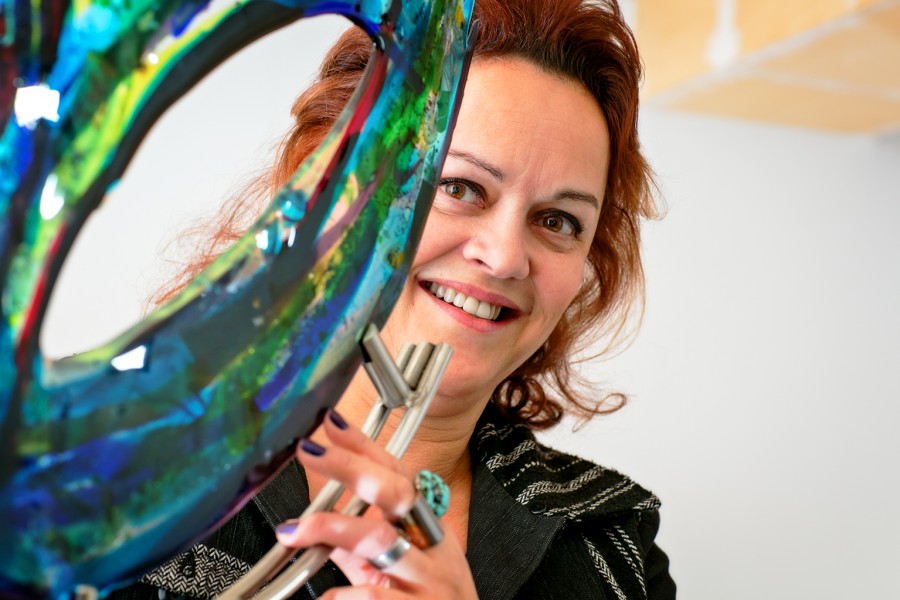

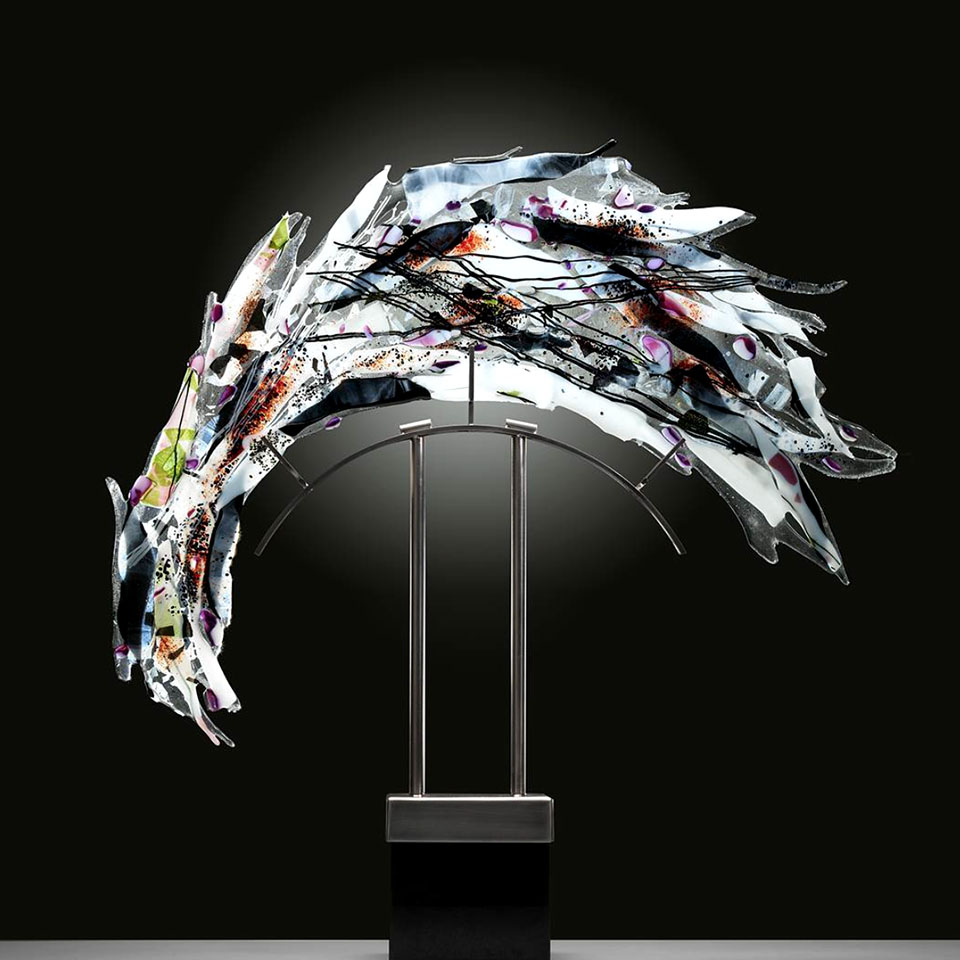

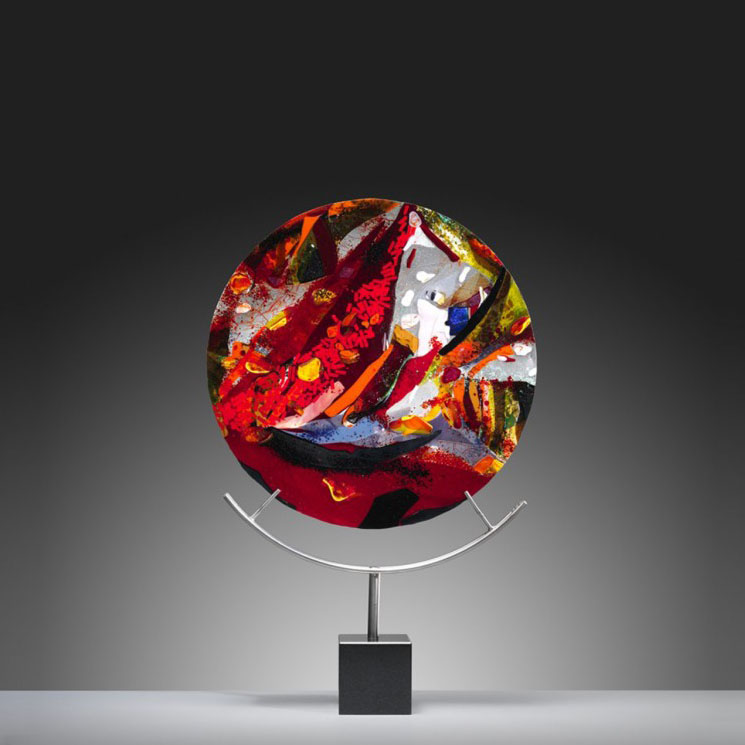



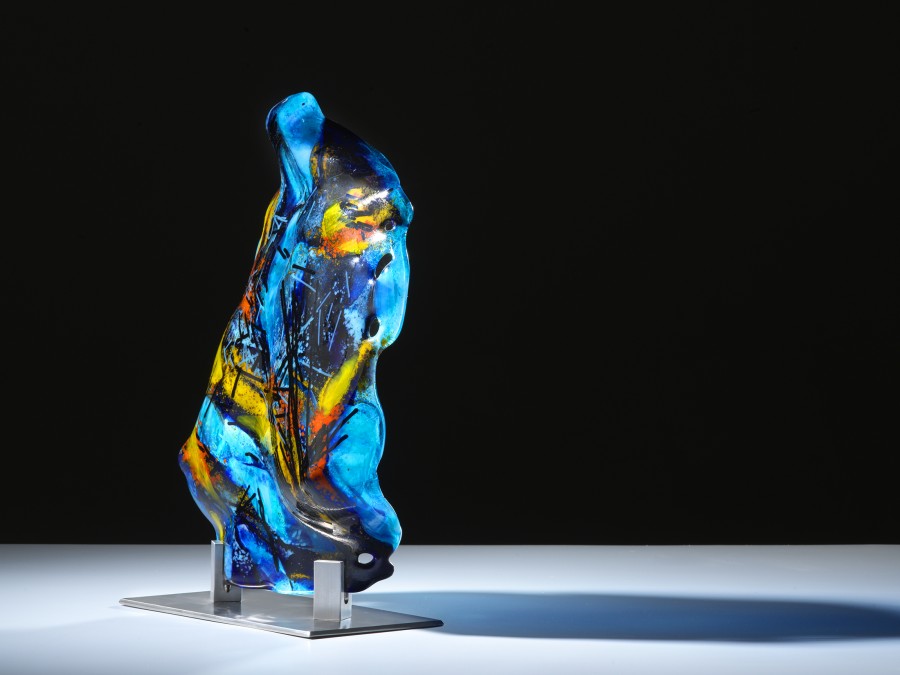



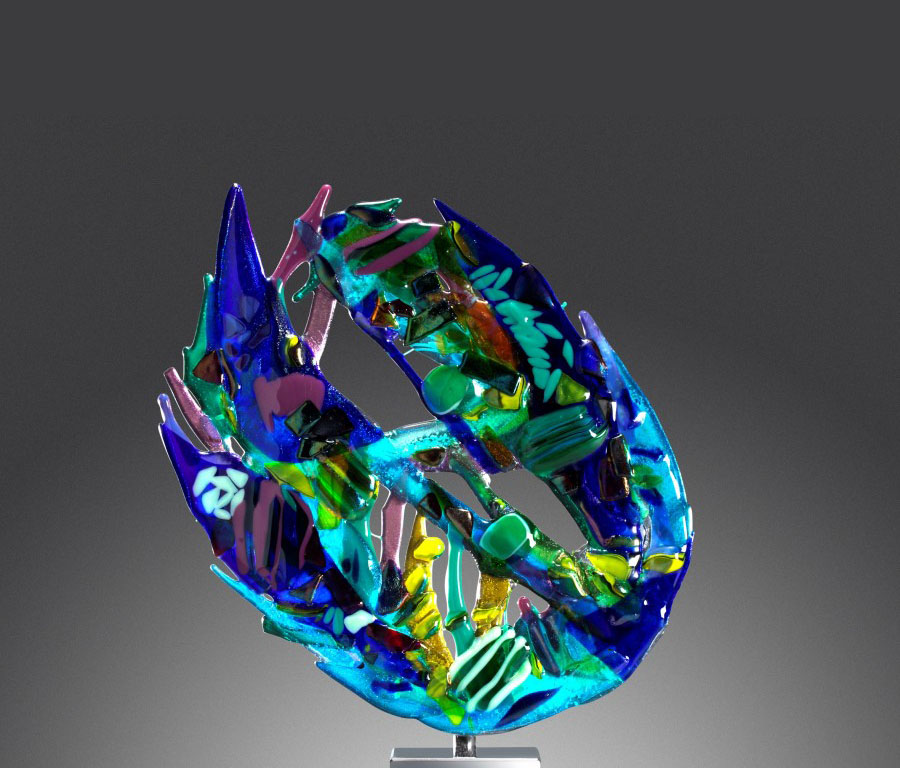



Comments